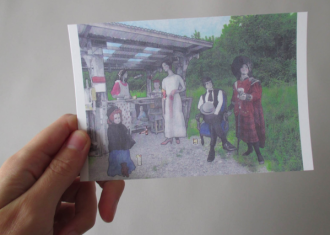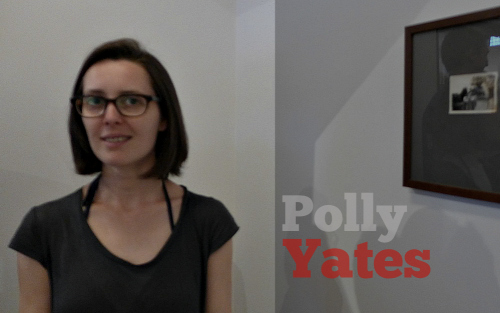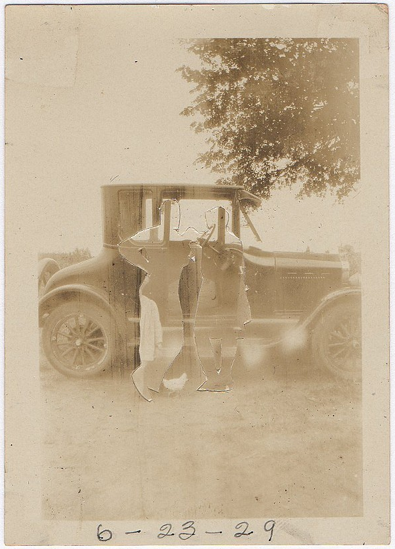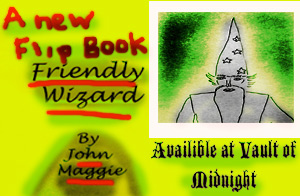This past summer, as I was killing knapwed at Water Street Commons, I had the good fortune of meeting Polly Yates, an artist from England who happened to be spending several weeks in Ypsilanti. After chatting with her a bit about her work, and the several pieces of artwork which have sprung up on Water Street, I asked if she’d mind if I followed up at some point in the future to asked her a few questions about art, food, sex and tramua. Well, she agreed, and we finally had an opportunity this past week to have that follow-up discussion.
MARK: When I met you, several months ago, you had a unique living arrangement. You were staying rent-free in Ypsilanti in exchange for yard work, right?
POLLY: Sort of. I was in Ypsi for an Artist Residency Program, which is run by Amy Sacksteder and Mark Dickson out of their lovely home in Ypsilanti. The name of the residency is YardWork, and, as a resident, you are (quite rightly) expected to chip in a bit, though not necessarily in the yard. Although I did do a spot of weeding.
MARK: How’d you find out about Ypsi, and the YardWork residency?
POLLY: I met Amy through a residency we both did in Berlin. She arrived just after I had left. In fact, she stayed in the room I’d been saying in. We both had work in a group show over there, and so we ended up talking via email. Once the show was over, we traded some work, and she very kindly invited me to do the residency.
MARK: How would you describe your work?
POLLY: My recent work is created from discarded family documentation – found photographs and Super 8 home movies. Usually there’s a kind of eye contact between the person taking the photo (or looking at it later) and the person being photographed. I alter these photos by making that eye contact impossible, and the person in the photo anonymous. They’re still recognisable as family documentation, though – recognisable as perhaps your own, or my own.
MARK: What is that that appeals to you about this kind of disconnected anonymity that you create?
POLLY: As family photos, they were once invaluable to somebody. Presumably, for these photos to be sold or thrown away, all the family members are no more, but once they were treasured, looked at, kept safe; because of this they have a particularly evocative quality to them; they are memories made material. Because they no longer belong to anyone, they have become abject. I find them beautiful and wanted to work with them in such a way that would preserve the secrets of the people photographed. [Below: Absences (two children holding hands), photo collage]
MARK: It makes one think about all of the traces we’re leaving behind us as we move through the modern world. When we’re gone, it won’t just be a half-dozen photographs in a shoe box. It’ll be thousands of Facebook comments, detailed medical records, cell phone photos taken by people who we don’t even know, interviews like this… One wonders how we may become art after we’re gone.
POLLY: We are lucky in that we are old enough for our teenage years to have happened before Facebook, etc… I long for shoeboxes.
MARK: Have you ever used your own family photos in your work, or those of people that you know, or do your subjects have to be unknown to you?
POLLY: The problem with my family is that they are all still alive! The photos we have are precious to us, and also they are limited. I have tried with some of them, but never really got very far.
MARK: What’s your process like?
POLLY: My process is always changing, and I am always looking for new ways of working. Right now, I am working in several different ways – with collage, with the large drawings and with objects – each line of inquiry progresses very slowly but each line also nudges the others along. I hope they will converge, at some point. Everything takes a really long time.
MARK: Under what circumstances do you do your best work? Do you have a set routine that you follow? Is there a specific place where you like to work?
POLLY: I hide away, listen to a lot of music, sing along, tunelessly. I hate deadlines and I am resistant to routines. I work at home, and I am steadily working on colonising the entire apartment.
MARK: Would I be correct to assume, given your accent, and the fact that you say things like “a spot of weeding,” that you’re English?
POLLY: Yes, that would be correct. I moved to the US with my partner about 3 years ago. We have managed not to pick up the accent yet, but we do wonder if we might start to slip.
MARK: Is that when you know that it’s time to go home… when you notice about either yourself or your partner that you’re beginning to pick up American mannerisms?
POLLY: I suspect we are becoming more English, in a stubborn way.
MARK: And how did you spend your time here in Ypsi, when not pulling weeds?
POLLY: I started work on a series of postcards about Ypsilanti that I’ve started sending back to the people that I met there… the first one went out recently. One of the ways Mark and Amy were most generous as hosts was the way they introduced me to lots of great people. I was interested in returning to those people my experience of Ypsilanti: work about Ypsi, for Ypsi. I was only there for 2 weeks, so I thought a lot about how I was experiencing the place within that limited timeframe – and I became interested in creating a kind of forced collaboration between the disparate places / things / people I had met or encountered; like a confused memory.
I also did a lot of drawing. My practice generally involves a lot of cutting things up and putting them back together so they work differently. It requires a lot of time spent searching and gathering and I realised that, alongside this, I need to make work that is looser and more spontaneous. The small drawings I began in Ypsi have developed into much larger scale drawings: feels quite revelatory working at such a different size and speed, and it’s the part of my art practice that feels the most like practice.
 MARK: The card that I received from you (seen right), seems to show historic Ypsilantians relaxing on modern Water Street. What can you tell me about this piece specifically?
MARK: The card that I received from you (seen right), seems to show historic Ypsilantians relaxing on modern Water Street. What can you tell me about this piece specifically?
POLLY: These are mannequins from the Ypsilanti Historical Society Museum – I got pretty entranced by them when I visited and knew I had to fold them in somehow.
MARK: When you said earlier that you like to make things that “work differently,” what do you mean?
POLLY: I make subtle interactions with found images or objects, so that, while they remain true to what they were, they are also gently transformed; I have a sense of correcting them, making them more “right” according to my own particular rationale. [Below: Untitled (Landscape), photo collage]
MARK: How was the Ypsilanti residency different from others you may have undertaken in the past?
POLLY: As a residency program it was very intimate – Mark and Amy made me feel like family, and, as I was the only artist in residence, I naturally spent a lot of time with them and got to know them both really well. We spent a lot of time comparing notes on books, music etc, and compiling lists for one another (something I always love) which you can see on their website.
MARK: What’s the last list that you made?
POLLY: I make them constantly. The last was a to-do list which I have been ignoring.
MARK: What was your sense of Ypsilanti?
POLLY: Well, first of all, as I’m English, I’m fairly thrilled by everything. I haven’t travelled much in the U.S. so far, so whenever I go anywhere new it feels like a revelation. Ypsi has a very strong sense of its own history, which I like. I collected these terrific old postcards of the area which became fodder for my own postcards. Clearly there’s a strong creative community… obviously there’s the YardWork residency, but I was also fortunate to meet many of the people behind the Ypsilanti Art Incubator, where I was able to exhibit some of my work. I loved the outdoor sculpture park on Water Street and the community that surrounds it. I came home wanting to recreate it in Chicago.
MARK: As the name of this interview series is “Art, Sex, Death and Trauma,” I should probably ask you about sex, death and trauma. Do you remember your first experience with death?
POLLY: The mind can’t compute death, can it? Its almost as if the mind, encountering death, has to rewire itself, like it is willing to tie itself into all sorts of knots to refute the possibility of it, which leads to a kind of madness.
MARK: Is this a madness that you have personal experience with?
POLLY: No more than anyone else experiences, I’m sure.
MARK: Have you personally ever had a near death experience?
POLLY: No, not really.
MARK: Do you believe in ghosts?
POLLY: I believe we are haunted. And I think of ghosts as being a kind of madness that comes from grief.
MARK: Grief in the past? Grief so powerful that it imprints across time?
POLLY: Well, I suppose grief can be handed down through generations, or (for example) a country could be haunted from its past… so yes.
MARK: Is America haunted by its past? Is England?
POLLY: Yes, very much so.
MARK: If you could come back as a ghost, how would you spend your days?
POLLY: I tend not to change much, so i’d just keep doing the same stuff I do now. Maybe walk through some walls.
MARK: Moving on from ghosts to food, as I’m sure you know, the British have a reputation in this country for not being the best of cooks. Is that a fair assessment in your opinion?
POLLY: More than fair! Still, I do miss it.
MARK: And what is it that you miss most about England?
POLLY: Oh, people. Having a keener sense of what is going on around me, socially or culturally. And the weather, too.
MARK: In addition to interviewing the most important artists of our day, I also interview Ypsilantians who have, for whatever reason, decided to leave Ypsilanti. Recently, when interviewing a woman who was leaving Ypsi to attend cooking school in Portland, she mentioned that, one day, she’d like to return and open a late-night fish ‘n chip shop. Given that you’re from England, I thought that you might have some insight in this area. First, where are the best fish ‘n chips in England? And, second, what makes them the best?
POLLY: I would like to visit that fish n’ chip shop. I’m glad it will be open late. Do you know what savaloy is? Its a sausage, an alternative to the normal sausage in batter, which is smoked and more of a pinky red. When I lived in the south of England, you could buy savaloy from the chippy, but when we moved to the north you couldn’t. It seemed at the time to be a huge cultural difference and I still marvel at it. I have never been a fan of chips served with gravy or mushy peas. I like a lot of salt and vinegar.
MARK: Are you purposefully avoiding my question as to the whereabouts of the best fish ‘n chip spot in England? By answering, would you be putting yourself in danger?
POLLY: Ha! No, wait, I do know a good chippy. Theres one near Waterloo station in London thats pretty good. On Waterloo road, I think. Not the best in England, or even in London, but maybe the best on Waterloo road. I’m not an expert, you see.
MARK: When did you know that you wanted to be an artist?
POLLY: Being an artist always seemed, and still seems, an impossibility. I have always liked making stuff.
MARK: Did you know artists when you were young?
POLLY: No, and I didn’t really go to any galleries or anything until i was much older. But my mum used to make her own clothes and my dad used to mess around with old cars, so I think I grew up knowing that you could work with your hands and make something of value.
MARK: What’s the most English thing about Ypsilanti?
POLLY: A good cup of tea at Mark and Amy’s – you should pop over and ask them to get the kettle on for you. I gave them some subtle pointers and now they don’t make tea like Americans at all, it’s a total joy.
MARK: Where do you live now?
POLLY: I live with my husband and our dog, Frankie in Chicago.
MARK: Is Frankie an American, or did you sneak him over from England?
POLLY: We got him here, he’s a rescue dog, so as far as we know he is American but to be honest his past is shrouded with mystery – he could be anything.
MARK: I suppose we’ve put the topic of sex off long enough… Instead of asking a question, what if I just give you an opportunity to make a statement? Is there anything you’d like to publicly declare about sex?
POLLY: Not especially.
MARK: That was really the only sex-related thing that I’d prepared for you. I guess that maybe, seeing as how you’re British, I should also ask you about Call the Midwife, though. I’ve only seen an episode or two, but there seems to be a lot of sex in it… So, do you like it?
POLLY: I haven’t seen it as we don’t have a TV. We live in a bubble of BBC Radio 4. We’re pretty disconnected… Are you sure you are not confusing sex with childbirth? They are connected, I hear, but not the same.
MARK: Good point… Here’s a related question. If you could be midwife to any historical figure from the earth’s past, who would it be, and why?
POLLY: Well, I suppose I could take such an opportunity to be the midwife to, say, Stalin and then choke him or something…
MARK: Hitler was the correct answer, but I’ll give you credit for Stalin… Another related question… Do you think that, if I were to produce a show about a very proper WWII-era midwife from England who materializes as a ghost in a modern American hospital, people would watch it? Please be honest.
POLLY: Mark, I would certainly watch it. [Below: Absences (6-23-29), photo collage]
MARK: Is there anything else that you would like to say about your work, your views on sex, your favorite foods, ideas for television shows, or upcoming projects?
POLLY: I recently did a drawing workshop here in Chicago at the new Roman Susan Gallery Annex, and I am looking forward to doing another one there with my good friend and collaborator Taylor Ervin; that should happen in February. I’ll have new work in a show at the Neon Heater Gallery in Ohio in June which I am currently working towards. I’ve been wanting to find a way of incorporating ceramics into my practice and I am thinking this might happen in 2015, so I am excited about that.
















7 Comments
It would be cool if one of our vacant storefronts downtown could be used for an artist residency program.
Good execution of the photo collages. They look great. Different from most others I’ve seen. My compliments to the artist.
@anonymous – I’ve always hoped the Maynard Battery space in Ann Arbor could host something like Providence’s http://AS220.org – but downtown Ypsi is a more likely possibility. Awesome to see Ypsi’s grassroots support for the arts, and nice interview, Mark!
It would be cooler if all that vacant space in Ypsi could be used to commerce.
*for
Once again I find myself agreeing with Mr. Larson. Commerce is more important than art.
I didn’t say that. Both are important.